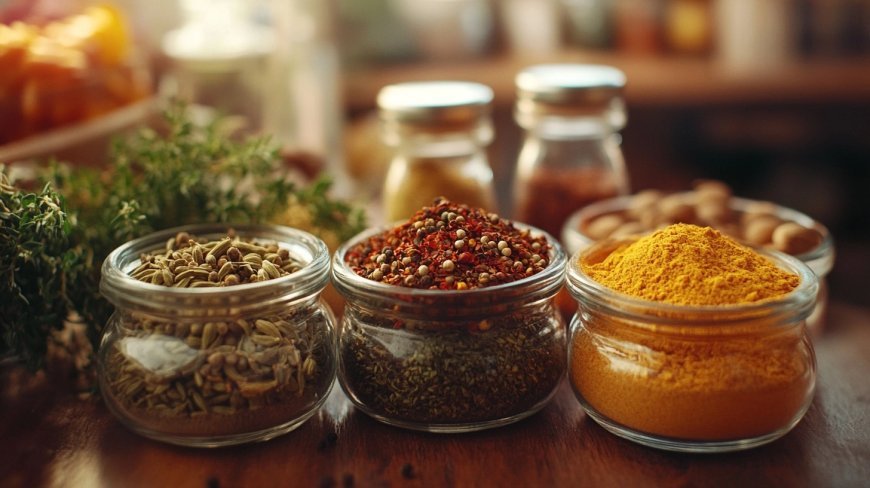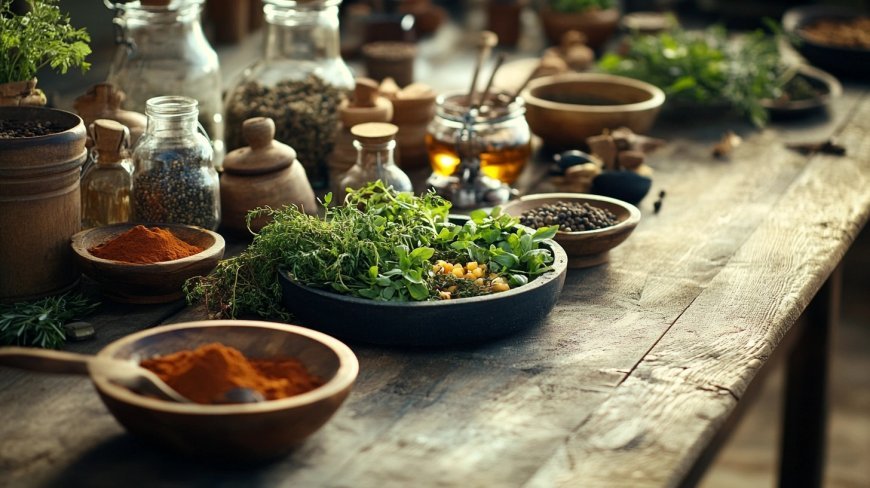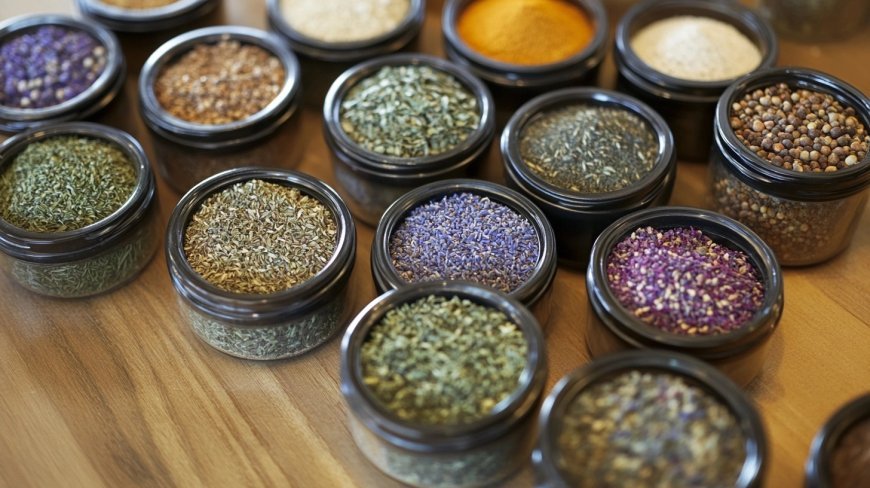The Ultimate Guide to Cooking with Herbs and Spices

Cooking is an art that transforms simple ingredients into extraordinary dishes. The key to mastering this transformation often lies in the use of herbs and spices—those magical ingredients that add depth, complexity, and excitement to food. Learning how to use herbs and spices effectively can elevate even the simplest of meals into something memorable. From the earthy warmth of cumin to the fresh brightness of basil, herbs and spices introduce a world of flavors to explore.
In this comprehensive guide, we’ll explore 20 essential herbs and spices, their flavor profiles, history, cultural significance, and how to use them effectively in your cooking. Whether you’re new to cooking or an experienced chef, understanding how to use these aromatic ingredients will help you add nuanced layers of flavor to every dish.

1. Basil
Flavor Profile: Sweet, slightly peppery, with a hint of mint and clove.
Historical and Cultural Background:
Basil has a rich history and is considered sacred in many cultures. Originating in India, it spread to the Mediterranean through trade routes and became a staple in Italian cuisine. It is also significant in Hindu rituals, symbolizing love and devotion. The Romans believed basil to be a symbol of fertility, and it was often planted around homes as a protective herb.
Culinary Uses:
Basil is a staple in Mediterranean and Italian cooking. Fresh basil adds a burst of flavor to dishes like pasta sauces, pizzas, and pesto. It pairs well with tomatoes, making it ideal for sauces, salads, and soups. When cooking with basil, it’s best to add it towards the end of the cooking process to preserve its delicate flavor. The aromatic oils in basil are volatile and tend to dissipate quickly under heat. Basil is also commonly used in Thai dishes, such as Thai basil chicken, where it adds a distinct sweet and spicy flavor.
Best Uses: Caprese salad, tomato sauce, pesto, pizzas, salads, herbal teas.
Tips for Consistent Results:
To maximize the flavor of fresh basil, avoid chopping it with a knife. Instead, tear the leaves by hand to prevent bruising and preserve its aromatic properties. If making a sauce, blend it into the dish at the very end to keep its vibrant green color and fresh taste. When making pesto, use a mortar and pestle rather than a blender to get a richer flavor.
2. Cilantro (Coriander Leaves)
Flavor Profile: Bright, citrusy, and slightly peppery.
Historical and Cultural Background:
Cilantro, also known as coriander leaves, is one of the oldest herbs cultivated by mankind. It has been used since ancient times in Egypt and was even found in the tomb of Tutankhamun. It traveled through Asia and is now a staple in Mexican, Indian, and Southeast Asian cuisines. Cilantro’s roots are often used in Thai cooking, where they provide an intense burst of flavor for curry pastes.
Culinary Uses:
Cilantro’s bright and zesty flavor makes it a favorite in fresh dishes like salsas, chutneys, and curries. In Mexican cooking, it is indispensable in dishes like guacamole and tacos, while in Indian cuisine, it adds a fresh contrast to spicy dishes. Unlike most herbs, cilantro leaves are best used raw or added right before serving to maintain their vibrant flavor. The stems are just as flavorful as the leaves and can be finely chopped and added to dishes for extra intensity.
Best Uses: Guacamole, salsas, curries, chutneys, garnishing soups, rice bowls.
Tips for Consistent Results:
Cilantro stems are just as flavorful as the leaves and should not be discarded. Chop the stems finely and add them to dishes like stews and curries to intensify the flavor. For those who find cilantro tastes soapy—a reaction caused by specific aldehydes—try substituting with parsley for a similar freshness. Another option is to use Vietnamese coriander, which has a slightly different but equally fresh flavor.

3. Rosemary
Flavor Profile: Woody, pine-like, and slightly peppery.
Historical and Cultural Background:
Rosemary is native to the Mediterranean and has been revered since ancient times as a symbol of memory and loyalty. The Greeks used it in religious rituals, and it is still used today in weddings and funerals across various cultures. It was also believed to ward off evil spirits and was often hung in homes for protection. The Romans used rosemary to improve memory and concentration, and it was later used as a medicinal herb during the Middle Ages.
Culinary Uses:
Rosemary’s needle-like leaves are aromatic and pair beautifully with roasted meats, particularly lamb, beef, and poultry. It also works well with roasted vegetables like potatoes, and its robust nature makes it suitable for long cooking times. The strong flavor of rosemary can hold up to roasting, braising, and grilling without losing potency. In Italian cooking, rosemary is often used to infuse olive oil, which can be drizzled over bread or used in cooking for a more intense flavor.
Best Uses: Roasted meats, focaccia, roasted potatoes, stews, marinades, infused oils.
Tips for Consistent Results:
Use rosemary sparingly, as its strong flavor can overpower other ingredients. For delicate dishes, infuse oils or broths with a sprig of rosemary and remove it before serving. Chopping fresh rosemary finely helps to release its oils, making it more potent when used as a rub for meats. For breads like focaccia, gently press whole sprigs of rosemary into the dough before baking to impart its aroma without overpowering.
4. Thyme
Flavor Profile: Earthy, slightly minty, and lemony.
Historical and Cultural Background:
Thyme is native to southern Europe and has been used for thousands of years in Greek, Roman, and Egyptian cultures. The Greeks believed thyme symbolized courage and purification, and soldiers often bathed in thyme-infused water before going into battle. During the Middle Ages, thyme was placed beneath pillows to encourage restful sleep and ward off nightmares. Today, thyme is one of the primary herbs in Herbes de Provence, a blend used widely in French cooking.
Culinary Uses:
Thyme is a versatile herb used across various cuisines to provide a subtle earthiness. It’s often used in French and Mediterranean dishes, particularly roasts, soups, and sauces. Thyme’s small leaves can be used fresh or dried, and it holds up well to heat, making it ideal for slow-cooked dishes like stews and braises. It’s also commonly used to flavor meats, fish, and poultry, and pairs exceptionally well with lemon and garlic.
Best Uses: Roasted chicken, soups, stews, roasted vegetables, marinades, compound butters.
Tips for Consistent Results:
The best way to use thyme is to add it at the beginning of cooking so that its flavor infuses throughout the dish. When using fresh thyme, slide your fingers down the stem to easily remove the leaves. If the stems are young and tender, they can be finely chopped and used in cooking. For an extra punch of flavor, use thyme in a bouquet garni (a bundle of herbs) to flavor stocks, soups, and sauces and then remove before serving.

5. Oregano
Flavor Profile: Earthy, slightly bitter, and aromatic.
Historical and Cultural Background:
Oregano originates from Greece, and its name means "joy of the mountain." In Greek mythology, it was believed that oregano was created by the goddess Aphrodite as a symbol of joy and happiness. The herb quickly became a key ingredient in both Greek and Italian cuisines, and has since spread across the globe, becoming synonymous with Mediterranean cooking. It is also a staple in Mexican cuisine, where it adds depth to spicy and tangy dishes.
Culinary Uses:
Oregano’s strong, earthy flavor is ideal for hearty dishes like pasta sauces, stews, and marinades. It pairs particularly well with tomato-based dishes and is often used in pizza sauces and Greek salads. Unlike some herbs, oregano retains much of its flavor when dried, making it an essential pantry staple. In Mexican cooking, dried oregano is added to beans, chili, and salsas to enhance the richness of the flavors.
Best Uses: Pizza, pasta sauces, Greek salads, marinades for meat, soups, Greek-style roasts, tacos.
Tips for Consistent Results:
Dried oregano is more concentrated than fresh oregano, so use it sparingly—usually one-third the amount of what’s called for in fresh oregano. Crush dried oregano in the palm of your hand before adding it to dishes to release its oils and enhance its flavor. Oregano can be combined with other herbs like thyme and basil for an Italian herb blend or with cumin and paprika for Mexican seasoning.
6. Parsley
Flavor Profile: Fresh, slightly peppery, and grassy.
Historical and Cultural Background:
Parsley has been cultivated for over 2,000 years and was originally grown in the Mediterranean. In ancient Rome, it was used as both a garnish and a medicinal herb, believed to aid digestion and freshen breath. Today, parsley is one of the most popular and versatile herbs worldwide, used in a variety of cuisines from European to Middle Eastern. It also plays a symbolic role in Jewish Passover celebrations, where it represents rebirth.
Culinary Uses:
Parsley’s fresh flavor makes it perfect for adding brightness to many dishes. It is often used in sauces like chimichurri and gremolata, and is an essential component of tabbouleh, a Middle Eastern salad. It can also be used as a garnish to enhance the presentation of a dish. Curly parsley is typically used for garnishing, while flat-leaf (Italian) parsley has a stronger flavor and is better for cooking. Parsley can also be blended into pesto for a different twist on the classic basil-based version.
Best Uses: Tabbouleh, chimichurri sauce, soups, salads, garnishing meat dishes, pasta, rice pilafs.
Tips for Consistent Results:
Use flat-leaf parsley when cooking as it has a stronger, more pronounced flavor. When using it as a garnish, finely chop the leaves and sprinkle them at the end for a pop of color and a touch of freshness. Avoid cooking parsley for too long, as it will lose its bright green color and fresh taste. To make a parsley oil, blend parsley with olive oil and a pinch of salt, then drizzle over grilled vegetables or fish for a burst of flavor.

7. Mint
Flavor Profile: Cool, sweet, and refreshing.
Historical and Cultural Background:
Mint has been used since ancient times for its medicinal properties, fresh aroma, and culinary versatility. Originating in the Mediterranean, it has spread globally and plays a significant role in Middle Eastern cuisine, especially in dishes like tabbouleh and lamb kebabs. In Greek mythology, mint was associated with hospitality and used in welcoming guests. Mint has also been a traditional remedy for digestive issues and is often brewed into teas for its soothing properties.
Culinary Uses:
Mint is a versatile herb that is used in both savory and sweet dishes. It pairs particularly well with lamb, as seen in Greek and Middle Eastern cooking, and adds a refreshing flavor to salads, sauces, and beverages. Fresh mint leaves are also commonly used in desserts, such as ice cream, fruit salads, and cocktails like mojitos. Mint's cooling effect makes it a perfect ingredient for summer dishes and cold drinks.
Best Uses: Mojitos, tzatziki, lamb dishes, fruit salads, iced teas, mint sauces, desserts, yogurt dips.
Tips for Consistent Results:
Fresh mint should be used sparingly, as it can overpower other ingredients. Tear the leaves rather than chopping them to prevent bruising and discoloration. If using mint in cooking, add it towards the end to maintain its vibrant flavor. When using mint in desserts or beverages, muddle the leaves gently to release their essential oils. To preserve fresh mint, store it in a glass of water like a bouquet and keep it in the refrigerator.
8. Sage
Flavor Profile: Earthy, slightly peppery, and savory.
Historical and Cultural Background:
Sage has long been associated with healing and was considered a sacred herb by the Romans. The Latin word for sage, “salvia,” means “to save,” reflecting its historical use as a medicinal plant. It was used in Europe during the Middle Ages for warding off evil and promoting longevity. Sage has been used in European and Mediterranean cuisines for centuries, especially in dishes that feature rich ingredients like meats and dairy.
Culinary Uses:
Sage is a powerful herb that’s often used in fall and winter dishes due to its comforting, earthy flavor. It pairs beautifully with rich meats like pork, duck, and turkey, as well as butter-based sauces and stuffings. Sage leaves can be used fresh or dried, and they are often fried in butter to create a simple but flavorful sauce for gnocchi or ravioli. Its robust flavor complements creamy ingredients, making it a popular choice for potato and pumpkin dishes.
Best Uses: Stuffing, roast poultry, sausage dishes, butter sauces, gnocchi, winter soups, roasted vegetables.

Tips for Consistent Results:
Because of its strong flavor, use sage sparingly—too much can easily overpower a dish. Fresh sage leaves are excellent for frying in butter until crispy, creating a rich topping for pasta or roasted vegetables. Dried sage works best in slow-cooked dishes like stews and roasts, where the flavor has time to mellow. Sage can also be combined with thyme and rosemary for a herb rub to enhance the flavor of roasted meats.
9. Dill
Flavor Profile: Sweet, grassy, with hints of anise.
Historical and Cultural Background:
Dill has a long history as both a culinary and medicinal herb. It was used by the ancient Egyptians for its healing properties and by the Romans for promoting digestion. In Nordic and Eastern European cuisines, dill is an essential herb, often used in pickling and fish dishes. It symbolizes good luck and prosperity in certain cultures and is often hung in homes as a sign of protection.
Culinary Uses:
Dill is a popular herb in Eastern European and Scandinavian cuisines, commonly used with fish, potatoes, and pickling. The feathery leaves of dill have a delicate flavor that’s perfect for adding a bright note to creamy sauces or salads. Dill is also an important ingredient in tzatziki, a Greek yogurt-based dip, and pairs well with dishes that have rich or fatty components to help balance the flavors.
Best Uses: Salmon, tzatziki sauce, potato salad, pickles, dressings, soups.
Tips for Consistent Results:
Add fresh dill towards the end of cooking to preserve its bright flavor and prevent it from becoming bitter. Dill seeds are also used in pickling and have a more pungent flavor compared to the leaves. When using dill in a salad or dip, mix it in right before serving to keep its taste and texture intact.

Cooking with herbs and spices is an exciting journey that allows you to explore different cultures and cuisines, all from the comfort of your kitchen. By understanding the flavor profiles, history, and culinary uses of these herbs and spices, you can experiment with combinations that complement and enhance the flavors of your dishes. Whether you’re preparing a simple weeknight meal or an elaborate feast, the careful use of herbs and spices can turn an ordinary dish into something truly extraordinary. Take time to appreciate the depth and complexity that these herbs and spices bring, and next time you cook, don’t hesitate to add a pinch of this or a sprinkle of that. You might just discover a new favorite flavor, and in the process, make your culinary creations far more memorable and special.

 Martin Joseph
Martin Joseph 





